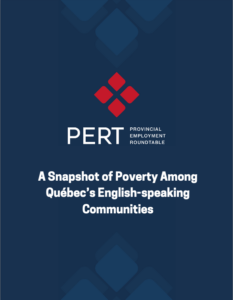| Morgan Gagnon, Policy Researcher, PERT
Sithandazile Kuzviwanza, Director of Policy & Research, PERT


|
|
This report presents a snapshot of poverty rates within Québec`s English-speaking communities. It reveals that the provincial poverty rate for English speakers stands at 10%, nearly double that of their French-speaking counterparts, who have a rate of 5.8%.
The report also highlights that English speakers in Québec are twice as likely to live beneath the low-income cut-off (LICO) level. Specifically, 8.9% of the English-speaking population in Québec live under the LICO threshold, compared to just 4.5% of French speakers.
The report also puts forth policy and programming recommendations to effectively address poverty and promote social inclusion among English speakers in Québec.
Recommendations
Linguistic Lens
- Adopt a linguistic lens to understand and analyze trends in economic precarity and poverty and advance solutions to combat poverty and social exclusion.
Global Supports
- Increase income supports available to low-income Quebecers and those living in poverty; ensure there are no French-language barriers to accessing and enrolling in income support programs.
French-language Learning
- Increase the availability and accessibility of French-language training for the working population.
- Increased investment in work-integrated language training programs.
- Raise awareness of the subsidies available to companies for French-language training of their employees.
- Develop programs that meet the diverse needs of learners.
Access to Wrap-around Supports
- Adopt a holistic approach to access to employment, which understands food security, housing, childcare, transportation, and mental and physical health as necessary precursors to employment.
Community-based Approach
- Develop closer collaboration between government and community organizations providing basic services such as accompaniment, translation, health information, and employment support.
Vulnerable Groups
- Develop targeted programming for specific English-speaking groups who experience higher rates of poverty, including wrap-around supports and employment programs for youth, seniors, visible minority groups and immigrants, and non-permanent residents.
|








